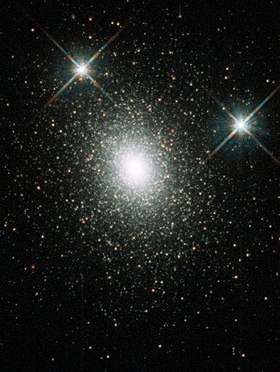M31 G1
| Mayall II | |
|---|---|

Hubble Telescope image of Mayall II, colour picture assembled from separate images taken in visible and near-infrared wavelengths in July 1994.
Credit: Michael Rich, Kenneth Mighell, and James D. Neill (Columbia University), and Wendy Freedman (Carnegie Observatories) and NASA |
|
| Observation data (J2000 epoch) | |
| Constellation | Andromeda |
| Right ascension | 00h 32m 46.51s |
| Declination | +39° 34′ 39.7″ |
| Distance | 2.52 ± 0.14 Mly (770 ± 40 kpc) |
| Apparent magnitude (V) | +13.8 |
| Physical characteristics | |
| Mass | 1×107 M☉ (2×1037 kg) |
| Radius | 21.2 ± 1.0 ly (6.5 ± 0.3 pc) (Half light radius rh) and tidal radius 263.2 ± 12.7 ly (80.7 ± 3.9 pc) |
| Estimated age | ~ 12 Gyr |
| Other designations | SKHB 1, HBK 0-1 |
Mayall II, also known as NGC-224-G1, SKHB 1, GSC 2788:2139, HBK 0-1, M31GC J003247+393440 or Andromeda's Cluster, is a globular cluster orbiting M31, the Andromeda Galaxy.
It is located 130,000 light-years (40 kpc) from Andromeda Galaxy's galactic core, and is the brightest (by absolute magnitude) globular cluster in the Local Group, having an apparent magnitude of 13.7. Mayall II is considered to have twice the mass of Omega Centauri, and may contain a central, intermediate-mass (∼ 2×104M⊙) black hole.
It was first identified as a possible globular cluster by American astronomers Nicholas Mayall and Olin J. Eggen in 1953 using a Palomar 48-inch (1.2 m) Schmidt plate exposed in 1948.
Because of the widespread distribution of metallicity, indicating multiple star generations and a large stellar creation period, many contend that it is not a true globular cluster, but is actually the galactic core that remains of a dwarf galaxy consumed by Andromeda.
...
Wikipedia
